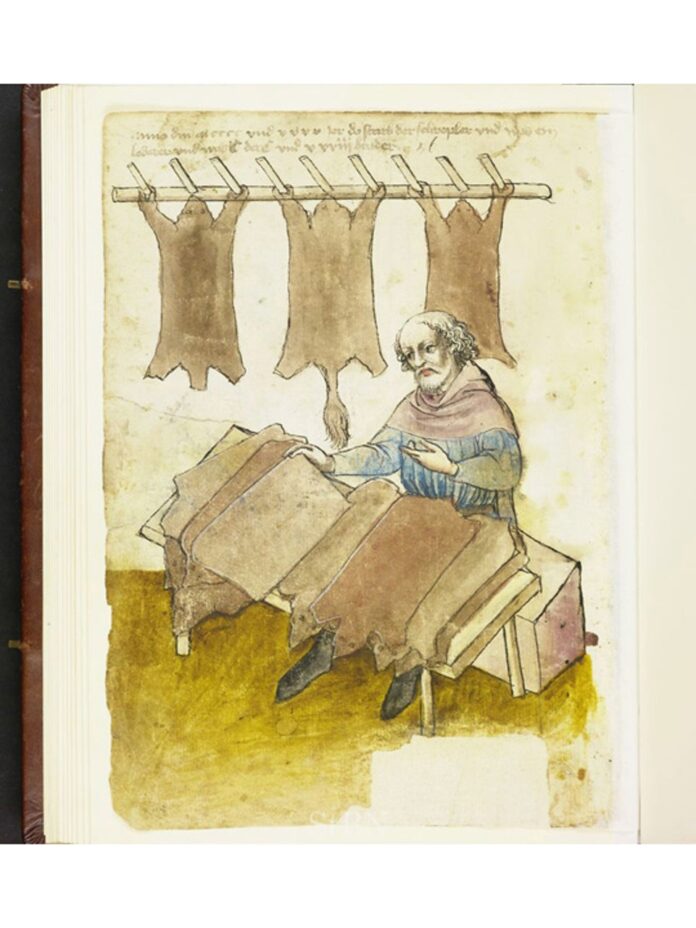The largest tannery yet discovered at a monastic site in Britain has been identified at Fountains Abbey in Yorkshire – revealing some remarkable new evidence about the community of monks and lay brothers who lived there and their central role in spreading Cistercian worship.
It had always been a puzzle what a long ‘bowling alley’ type extension of the east side of the Fountains Abbey precinct, close to the River Skell, could have been used for.
Now, ground penetrating radar, backed up with other geophysical survey methods, carried out in partnership with National Trust by the University of Bradford, Mala UK, Geoscan Research and Magnitude Surveys, has made unexpected discoveries of unknown monastic buildings filling the whole width of the valley floor of the World Heritage Site.
The find reveals two substantial stone buildings, 16 metres wide, one of them at least 32m long and more than a single storey in height, with lined pits, tanks and other structures around them. These, along with the proximity to the river for water – a key requirement for the tanning process – has led to the conclusion that this was the tannery serving the community of Fountains Abbey.
Tanning was a vital part of the abbey economy where animal hides would be de-haired and cured to make leather for uses such as clothing, belts, bedding, book bindings and vellum or parchment for reproducing religious texts by the monastic scribes. Nevertheless, the sheer scale of this discovery, and where it is sited close to the rest of the abbey community, has surprised archaeologists.
Mark Newman, National Trust archaeologist explained: “A tannery of this size, spanning such a large area of the site, reveals an operation on an industrial scale, meeting the needs for leather and other processed animal skins for the community of hundreds of people in the growing monastic community. Its scale also reflects an aspect of the productivity of the huge herds the abbey acquired and managed.
“Also, given the noise, activity and stench that emanated from a tannery, we previously thought that it would have been sited further away from the monks and their worship. We see now that the tannery was much closer and a far cry from the idea of a quiet, tranquil abbey community.
“Fountains is today an oasis of tranquillity but in twelfth and thirteenth centuries in particular, it was as busy and industrialised a piece of landscape as you would have found anywhere in Britain. The bulk of the abbey’s needs for food processing and working raw materials took place in structures set around the wider precinct. ”
Man occupied in the leather producing industry, shown sorting skins after drying.
These latest findings probably also show the importance of lay brothers on the site. Lay brothers followed a different daily round of religious observance: they were not literate like the monks and were often recruited as mature men to bring crucial craft skills to the monastery, relieving the monks from most physical jobs so they could be free to dedicate more time to study, prayer and worship. However, lay brothers were “Separate but Equal” according to St Bernard, creator of the Cistercian Order, not intended to be inferior to the monks.
Mark continued: “The huge scale of the lay brothers’ accommodation (refectory and dormitory) we have already identified on the site shows how important they were to the economic model that Fountains adopted early on, laying the foundations for the abbey’s remarkable success. The tannery is especially linked to this as the lives of the lay brothers were distinguished from those of the monks in dress as in much else. While monks had woollen habits and cloth blankets to sleep under, lay brothers were provided with weatherproof animal skin capes for outdoor work and slept under sheepskins. Fountains recruited hundreds of lay brothers in its early decades all of whom needed to be equipped this way – and this tannery provided the means for that.”
The lay brothers and the tannery were also central to the whole monastic mission in that one of Fountains’ purposes was to “grow” communities of monks capable of leaving the Mother house to form new monasteries – across the North and even into Norway. The sites of new houses would be prepared by teams of lay brothers, and the new community would be furnished with sets of religious texts, copied by the monks at Fountains on vellum and parchment prepared from animal skins. The project team believe that the newly discovered building may have been where the vellum and parchment was produced, both at their inception and perhaps in the early years of the lives of the new monasteries as they grew.
The need for leather and parchment continued throughout the abbey’s life, and whilst in later years the numbers of lay brothers reduced (due to social changes including better economic and other opportunities outside the abbey community) the tannery remained in operation right until the last days before the Dissolution of the Monasteries in October 1539. This is described in some detail in a lease of the early 1530s.
Recognition of the scale of the community of lay brothers may help to explain the very large number of burials previously discovered in the monastic cemetery nearby. Monks and lay brothers were buried together as equals.
Mark Newman added: “The scale of the operations we’ve discovered here really takes one aback, but it all fits the bigger picture once you get over the initial surprise. The Cistercians – and especially the community at Fountains – were pioneering farmers and land managers on an industrial scale. They had to be, to support the enormous religious community that rapidly built up and the vast building projects they undertook, in praise of God.
“Their wealth was originally based on wool, but later diversified into cattle-raising too, while the need for processed animal skins was constant throughout the abbey’s life. In later years, when the herds were mainly managed by lay tenants as part of their rent, even the skins of any fallen stock had to be brought to the abbey for curing, so that as much as possible was put to practical use”.
Chris Gaffney, Professor of Archaeological Sciences at the University of Bradford commented: “Geophysical survey at Fountains Abbey continues to provide us with stunning, unexpected and intriguing glimpses into life in the past at the site. Each high-resolution dataset is of great interest in imaging the buried archaeology but visualising these with the digital model that we have created of the upstanding remains has provided a completely new ‘view’ of the site. As the technology advances, so does our understanding of the archaeology at Fountains Abbey.”







